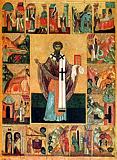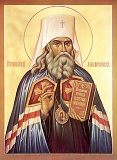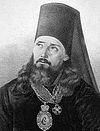

| Previous day | Next day |
| Old Style
March 31
|
Saturday |
New Style
April 13
|
|
5th Week of Great Lent. Laudation of the Most Holy Theotokos. The Akathist of the Most Holy Theotokos.
Tone 4.
Great Lent. |
Wine and oil allowed.
|
![]() St. Hypatius the Wonderworker, bishop of Gangra (ca. 326).
St. Hypatius the Wonderworker, bishop of Gangra (ca. 326). ![]() St. Jonah, metropolitan of Kiev, Moscow, and all Russia (1461). St. Innocent, metropolitan of Moscow, enlightener of Alaska and Siberia (1879).
St. Jonah, metropolitan of Kiev, Moscow, and all Russia (1461). St. Innocent, metropolitan of Moscow, enlightener of Alaska and Siberia (1879).
St. Apollonius, monk, of the Thebaid (4th c.). Hieromartyrs Abdas, bishop of Hormizd-Ardashir, and Benjamin, deacon, of Persia (418-424). St. Hypatius, abbot of Rufinianus in Chalcedon (ca. 446). St. Hypatius the Healer, of the Kiev Caves (14th c.). St. Philaret, abbot, of Glinsk Hermitage (1841).
Iveron Icon of the Most Holy Theotokos (Mt. Athos).
Righteous Joseph the Fair, son of Jacob (ca. ) (ок 1700 b.c.). St. Acacius the Confessor, bishop of Melitene in Pisidia (251). St. Blaise of Amorium and Mt. Athos (ca. 908).
Repose of Archbishop Averky (Taushev) of Syracuse and Holy Trinity Monastery (1976), Schemanun Anastasia (Shevelenko) of Karaganda (1977), and Archimandrite Thaddeus (Tadej) (Shtrbulovich) of Vitovnica Monastery, Serbia (2003).
Thoughts for Each Day of the Year
According to the Daily Church Readings from the Word of God
By St. Theophan the Recluse

Saturday. [Heb. 9: 24–28; Mark 8: 27–31]
The Lord asked the apostles how they see Him? In the person of the holy Apostle Peter, they answered Thou art the Christ. This confession did not ripen suddenly, but once it ripened, it settled in the depths of the heart and became the source of his guidance. It was overshadowed by the death of the Lord, but not shaken, and being resurrected in even greater power by the resurrection, it directed the apostles for their entire lives to preach to the whole world. There is a moment for each believer, when he utters with all his strength, “Thou art the Christ, my Lord and Saviour. Thou art my salvation, my light, my strength, my comfort, my hope and eternal life.” Then is accomplished that by which this believer cries with the Apostle: “Who shall separate me from the love of Christ!” (cf. Rom. 8:35) and like him he begins to pursue all that is pleasing to Christ the Lord until he comes unto the measure of His stature (cf. Eph. 4:13).
Articles
 St Jonah the Metropolitan of MoscowSaint Jonah, Metropolitan of Moscow and Wonderworker of All Russia, was born in the city of Galich into a pious Christian family. |
 Icon of St. Innocent of Moscow weeping myrrh In KhabarovskThe unusual phenomenon was noticed by the seminary aspirants who came to take entrance examinations. |
 Venerable Apollonius, Ascetic, of EgyptSaint Apollonius, when he was a fifteen-year-old youth, withdrew into the inner Thebaid desert (Lower Egypt), where he spent forty years in monastic struggles. |
 Venerable Hypatius the Healer of the Kiev CavesSaint Hypatius the Healer of the Caves, attained glory through his severe fasting and prayerful vigilance. |









